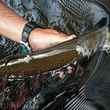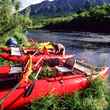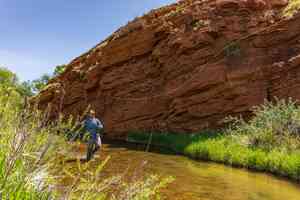It’s an almost ungodly sight. It doesn’t seem real. Not when you catch that first glimpse, and not when you’re standing there among a throng of tourists at the Talkeetna overlook, each of whom is asking the same question: “Is that really Denali?”
It can’t be real, can it? Those rocky crags in front of it… the ones that look like the Tetons—only bigger—they might be real. But that massive white-cloaked behemoth of a mountain behind them? That’s not real. It can’t be.
But Denali is real, all 20-some-thousand feet of it. On rare clear days, it is the Alaska skyline—a massive preserve of rock and ice that looms menacingly over the interior like a moody schoolmarm just waiting for a reason to be cranky.
But mostly, it hides. It’s altitude alone is enough to alter the weather around it, and with weather patterns influenced by the North Pacific, the Bering Sea and the Arctic Ocean all pushing into the Alaskan midriff, the tallest peak in North America is only visible about 20 percent of the time.
Twenty percent. Imagine going to Alaska and visiting Denali National Park and not seeing Denali itself. It’s like going to Disneyland and finding out Space Mountain is closed.
Thankfully, as summer drained into fall, I got a good look at the mountain, even though my mission was a bit less grand. Well, at least it was less grand to those whose sole goal along the Parks Highway north of Anchorage was to see Denali—I was fishing for fat rainbows in the clearwater tributaries that drain into the Susitna River. Denali was a welcome distraction from swinging flesh flies for the voracious leopard-spotted fish in streams with names like Byers Creek, Fish Creek and Troublesome Creek.
And I suppose that the sight of Denali made good fishing even better.
But it was fleeting. As my fishing buddy, Laura Orr, the lead fishing employee at the Bass Pro Shops in Anchorage, stopped to sample streams between Talkeetna and Cantwell, the mountain slipped behind the clouds and disappeared for the rest of our trip north.

But the rainbows—and the grayling farther north—didn’t disappear. We took a hard right onto the Denali Highway and ventured miles east along the gravel road into the interior and killed the last days of August in what might be best described as November weather. The rain froze into sleet, which quickly turned into snow. The wind pushed through every seam in our GoreTex. But the grayling kept biting, hitting gaudy Egg-sucking Leeches and even taking stabs at the bright orange indicators we floated above beefy Prince Nymphs and Girdle Bugs. The fish were on eggs, it seemed, even though the first of the silver salmon that migrated that far inland were still weeks downstream in the glacial gray waters of the Susitna.
And all the while, Denali loomed above us, yet remained shy behind the slate-gray skies that spit ice and frigid raindrops on us as if trying to prove that Alaska is a hell of a lot tougher than two transient fly fishers with the nerve to take the rental car off the pavement.
Even later, when we actually ventured into Denali National Park to chase grayling—just to say we did, really—the mountain withheld itself from us, concealed by the low, threatening clouds.
We pulled the car over to the side of the highway to watch two massive bull moose spar amid the scrub and the squatty spruce trees of the north. We slowed to check out chicken-sized spruce grouse lingering on the road’s edge. We stopped at each overlook to take in the Alaskan scenery where, seemingly, every camera viewfinder settles on a vista worthy of a postcard.

But after showing us, just once, its peak and all its high-country splendor that rings its bottom like a slightly revealing cocktail dress rings the thighs of a curvy dame out for a night on the town, Denali remained veiled, camera shy.
Thankfully, the fish that swim in the waters that meander around the mountain’s massive footprint were not shy. They came out to play. Sporty Arctic grayling chased flies and didn’t seem bothered in the least by the sour weather that Denali no doubt helped construct. Fat rainbows hit streamers in stretches of stream so pristine, so perfect, so damn fishy, that it’s as if they were created for the sole purpose of satisfying itinerant anglers who wanted little more than to pull these gorgeous trout from their waters and return the fish back to them, largely unharmed, but perhaps a bit smarter.

It’s as if the mountain trusts those who visit the waters around it, but not completely. Denali appears just often enough to check in, to see for herself that those of us lucky enough to wander the banks of her streams are behaving. That we’re treating the rivers right, and respecting the fish in them.
Truthfully, anglers the world over worship the fish that call Denali’s waters home, but it’s nice to have that 20,000-foot reminder. This is Alaska, after all. It’s been so hard to tame and gentrify that it remains a wild and feral place where visitors can experience vistas like those offered—although infrequently—by Denali or the waters that shape the Alaskan low-country. Or the fish that swim there, but then leave and take only memories away.

Fishing in the shadow of Denali—even when Denali refuses to be seen—is an experience so visceral, so reverent that there is no incentive to leave behind any trace. Misbehaving on the waters around Denali would be so disrespectful to the thoughtful fly fisher—like farting in church, or heckling at a Broadway production—that it’s simply unthinkable.
It’s not just a mountain. It’s a monument to what Alaska is and has always been. For anglers, it’s a reminder of where they are, and that they’re fishing holy waters overseen by a sentinel so grand that a single cast in the waters under its watch must be valued. Appreciated.
That’s why we behave.






























Comments